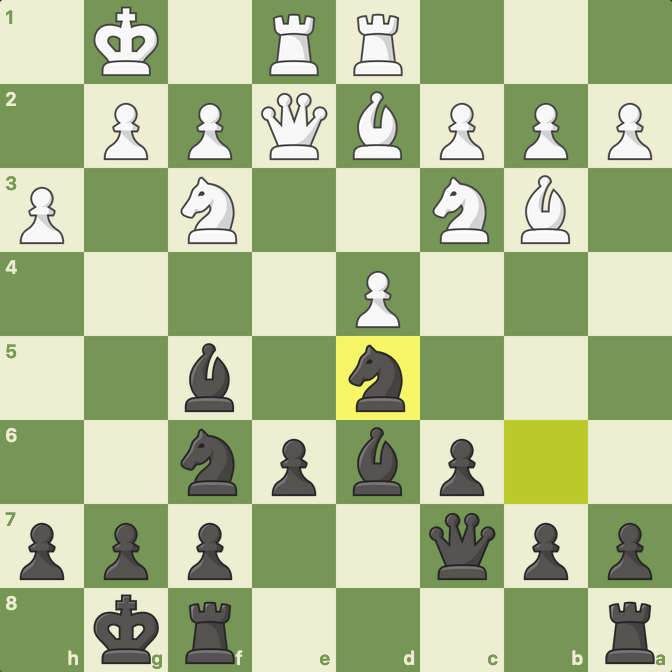
Carlsbad Pawn Structure
The Carlsbad pawn structure is a well-known pawn structure that can arise from many different openings. Let's learn more about this pawn configuration.
Here is what you need to know about the Carlsbad pawn structure:
- What Is The Carlsbad Pawn Structure?
- Why Is The Carlsbad Pawn Structure Important?
- Carlsbad Pawn Structure Plans
- Conclusion
What Is The Carlsbad Pawn Structure?
The Carlsbad pawn structure can be reached via many openings but is best known from the Queen's Gambit Declined Exchange Variation, which occurs after 1.d4 d5 2.c4 e6 3.Nc3 Nf6 4.cxd5 exd5 5.Bg5 Be7 6.e3 c6:

This particular opening line was popularized at the 1923 Carlsbad tournament, hence the name "Carlsbad pawn structure" is used to describe this famous structure. If we remove the pieces from the above diagram, we can see the pawn structure alone:

As you can see, both sides have two pawn islands, and White has traded their c-pawn for Black's e-pawn resulting in half-open files. White has two queenside pawns on a2 and b2, while Black has the queenside pawn majority with pawns on a7, b7, and c6.
Why Is The Carlsbad Pawn Structure Important?
The Carlsbad pawn structure is important because it is full of rich possibilities for both sides and because the structure that can be reached via many openings, including the Nimzo-Indian, Caro-Kann, Scandinavian, and multiple other queen's pawn openings.
Let's take a look at how we can reach the Carlsbad pawn structure from some of these openings from Black's perspective. In the Caro-Kann Exchange Variation, we can reach the structure after the moves 1.e4 c6 2.d4 d5 3.exd5 cxd5 4.Nf3 Nc6 5.Bd3 Bg4 6.c3 e6:

In this position, Black has reached the Carlsbad pawn structure. In fact, this is an almost identical position as the Queen's Gambit Declined Exchange Variation, just with colors reversed. If we remove all of the pieces, the Carlsbad pawn structure appears again:

Let's take a look at a variation of the Scandinavian Defense. After 1.e4 d5 2.exd5 Qxd5 3.Nc3 Qa5 4.d4 c6 5.Nf3 Nf6 6.Bd2 Bf5 7.Bc4 e6 8.0-0 Qc7 9.Bb3 Bd6 10.Qe2 0-0 11.Rfe1 Nbd7 12.Rad1 Nb6 13.h3 Nbd5, we have reached a position from the Qa5 line of the Scandinavian:

The pawn structure above is not a Carlsbad, but if White captures on d5 and Black recaptures with the c6-pawn, we have again arrived at the Carlsbad pawn structure. Here is the same position after 14.Nxd5 cxd5 15.c3:

As we have seen, Black has essentially traded his c-pawn for White's e-pawn and has two queenside pawns versus White's queenside pawn majority—another example of the Carlsbad pawn structure. As mentioned, this pawn structure also has an incredibly rich amount of possibilities with great plans for both sides. Let's take a look at some of these plans.
Carlsbad Pawn Structure Plans
The most well-known plan in the Carlsbad structure is the minority attack, which occurs when fewer pawns attack a larger pawn chain. In the Carlsbad pawn structure, this attack is achieved by pushing the two queenside pawns toward Black's queenside majority.

The goal of the minority attack is to favorably change the pawn structure on the queenside. Here is a classic example of a minority attack conducted by former world champion Jose Raul Capablanca in his game against Harry Golombek in 1939:
Another common plan in the Carlsbad pawn structure is to play for the central break with e3-e4, usually with the help of the f-pawn moving to f3 to support the e4-push.

The goal of the e3-e4 break is to gain space in the center. Here is a classic example of the e4 central break in action from the 1993 World Championship match between GM Garry Kasparov and GM Nigel Short. Kasparov's central pawns proved too much for Short to handle:
Another respected plan in this pawn structure is known as the Pillsbury Attack, where White plants his knight on e5 and then supports this knight with the f2-f4 push. This plan usually involves a kingside attack. Here is a game example from Harry Pillsbury himself as he conducts a brilliant kingside attack:
These are just a few of the most well-known plans in the Carlsbad pawn structure. There are many others to know, but these are great places to start if you plan on adding an opening that uses this pawn structure to your opening repertoire.
Conclusion
You now know what the Carlsbad pawn structure is, why it is important, how it can be reached, and more! Check out this great series of videos by GM Dejan Bojkov or these other Chess.com videos on the Carlsbad pawn structure for more information.







